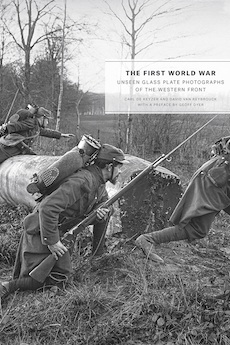By Benjamin Franklin Martin
The horrors of the Great War always previously have been viewed in monotone photographs, grainy because reproduced from an original image. The glass plate “negatives,” from which prints with a higher level of detail and grey scale could be rendered, rarely survived. Battlefield conditions ensured some breakage, but more important were wartime shortages which led photographers to wash used plates and so recover the silver nitrate in the collodion emulsion.
Now, those very horrors of the Great War can be viewed in new astonishing detail and sometimes in color. Here is a collection of 100 images produced in large-format from glass plates recently discovered by Carl De Keyzer as he hunted through photographic archives. The photographers are French (Jean-Baptiste Tournassoud, Isidore Aubert, Paul Castelnau, Léon Gimpel, Fernand Cuville, and Albert Moreau), Belgian (Maurice and Robert Antony, N. Lajot, and Arthur Brusselle), German (Richard Hammann), and Tunisian (Albert Samama-Chikli).
Of their photographs, hardly a single one is less than extraordinary. Some are darkly forbidding: Aubert’s of the shadowed factory floors where French workers, male and female, manufacture artillery shells and grenades. Others are harrowing: the utter destruction at Verdun by Tournassoud, at Ypres by the Antony brothers, at Reims by Castelnau, and at Diksmuide by Brussselle. One series by Gimpel is haunting, Paris schoolboys playing at being soldiers and aviators and carrying out the mock execution of a captured German: none of them were old enough to fight in this war, but likely all of them would fight in the next.
Benjamin Franklin Martin (ΦΒΚ, Davidson College, 1969) is the Price Professor of History at Louisiana State University and a resident member of the Beta of Louisiana Chapter of Phi Beta Kappa.




